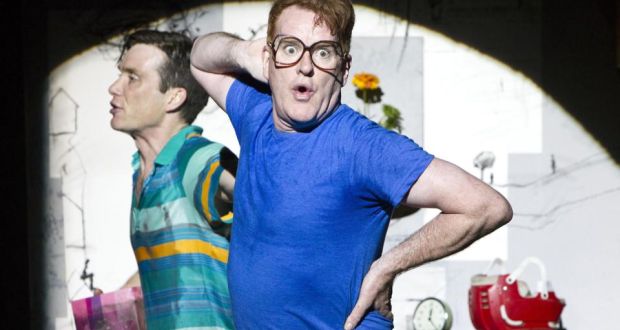**** Cillian Murphy ‘underlines his character’s restless spirit with manic eyes and a multi-octave voice’, while Mikel Murfi depicts ‘gormlessness with spry physical genius’, in Ballyturk.
Ballyturk, a place that may or may not exist, still seems strangely familiar. We are in a huge sealed room, a sparse industrial space of light greys and rust browns, designed by Jamie Vartan, where two men frantically fill the time in daily routines, 1980s pop songs and hyperkinetic story telling.
In a madcap soap opera, they select characters from a gallery with the throw of a dart, split eccentric role play and grandiloquent narration between them, and furiously inscribe some sort of reality, out of nothing. In short, they are trapped, exhilaratingly and unnervingly, in an endless Enda Walsh play.
The two nameless character, a reedy Cillian Murphy, who underlines his character’s restless spirit with manic eyes and a multi-octave voice, and Mikel Murfi’s older protector, depicting gormlessness with spry physical genius, are hardly aware of that – they have been entombed here for a long time. But, as writer and director of Landmark and GIAF’s production, Walsh scatters arch self-references through their world: jumbled props, small-town meditations, co-dependent character dynamics and surreal set pieces that recall his entire oeuvre, and all the snack foods familiar from his junk-culture absurdism. He even performs a very discreet cameo role.
That might sound like self-parody, but Walsh seems intent on ushering his stagecraft towards a more profound seriousness, something underlined with the visceral portent of Teho Teardo’s solemn music and the arrival, by means of a coup de théâtre, of Stephen Rea.
Rea’s figure, urbane and quietly commanding, may strike you either as a god or a reaper – “I’m a collector,” he tells the nonplussed pair. “That’s why I’m here.” – but he most resembles a playwright; he calls the shots. Perhaps that’s why Walsh’s conscience seems to gets tangled up, relishing the poetic fumblings of the players, but constructing lengthy monologues for Rea with no particular function or voice. It’s strangely anti-climactic, as though Godot had shown up.
The dilemma Rea offers, though, shadows the play’s fundamental concern: that there is more to existence than we can comprehend. “I thought we knew everything there was to know,” says Murphy, shaken to his core by the discovery of a new creature – a fly. “It feels like we may be less of what we were in a place we don’t wholly know.” But while Murphy yearns for freedom, in sleep, in dreams, in distended memories, Murfi is in love with the prison, the sustaining rituals, the finitudes of known space.
Even in the self-reflexive theatre of Walsh, there’s something fresh in layering the play with metaphors for life and death. Like Murphy’s childishly drawn map of Ballyturk, plays are also bound by limits, strict and quantifiable, while seeking to describe something much greater. Ballyturk is dark and giddily disturbing, not because it constructs a place, or a prison, but because it is provides a springboard, propelling us into the unknown.
Until Jul 27, then tours to Olympia Theatre, Dublin Aug 7-23, Cork Opera House, Aug 26-30 and the National Theatre, London Sep 11-Oct 11
Written by Peter Crawley in The Irish Times 15.07.14
